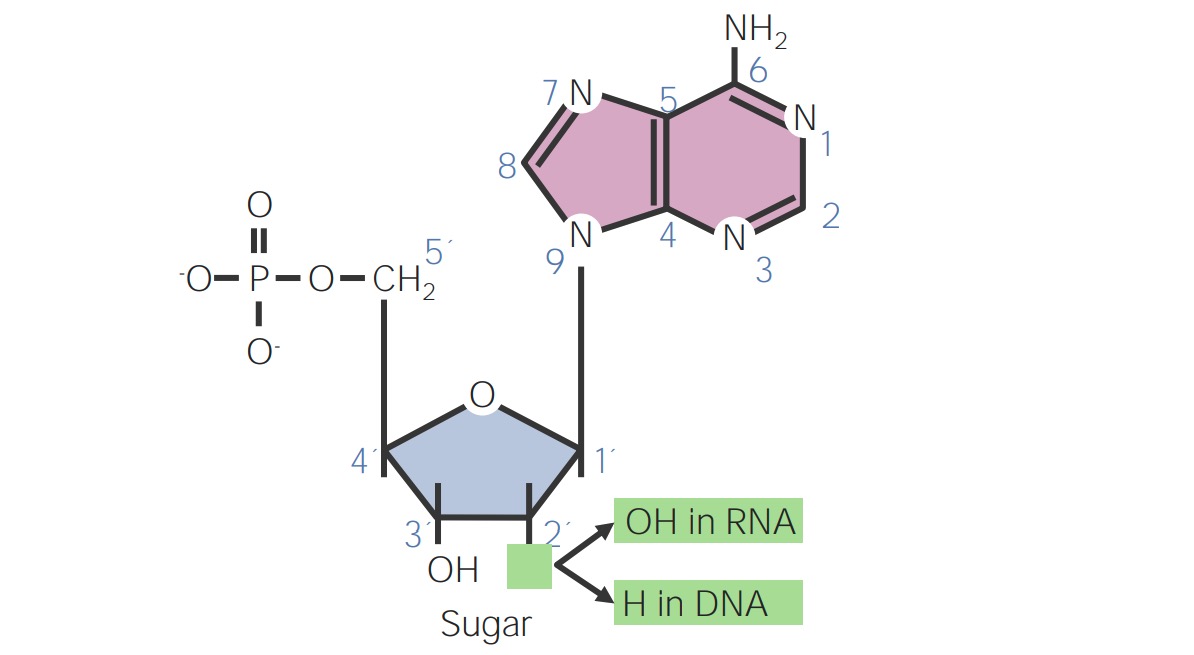Playlist
Show Playlist
Hide Playlist
Nucleotides – DNA, RNA and the Genetic Code
-
11 Basic DNA&RNA&GeneticCode I.pdf
-
Biochemistry Free and Easy.pdf
-
Reference List Biochemistry.pdf
-
Download Lecture Overview
00:01 Though what happens in cells may appear to be chaotic, in fact the overall process is highly, tightly regulated. We know the central dogma specifies that DNA, makes RNA, makes protein. In this module I will talk about some considerations of that to help us better understand the process. First I'll talk about nucleic acid structure because understanding structure is important to understanding function. Next I will talk about how the DNA is replicated in very general terms. And then last I'll talk about the synthesis of RNA from DNA, the process of transcription. 00:35 Now when we consider the nucleic acids, DNA and RNA, we have to first of all understand some things about their structure. The building blocks of DNA and RNA are nucleotides and these nucleotides can be broken into two different groups, deoxyribonucleotides and ribonucleotides, you can see them on the screen here. Now these nucleotides have some common features associated with them. First each has a high energy triphosphates, the three phosphates linked together hold a lot of energy. They each have a sugar, in the case of the deoxyribonucleotides, that sugar is called deoxyribose, in the case of the ribonucleotides, that sugar is known as ribose. Last, each of these have a base and the base can be one of four different bases, in the case of the deoxyribonucleotides, the bases are adenine, guanine, cytosine or thymine. 01:28 Ribonucleotides have three of the same bases, adenine, guanine and cytosine, but instead of thymidine, they have uracil. 01:37 This figure shows the structure of the four deoxyribonucleotides, deoxyadenosine triphosphate known as the dATP, deoxyguanosine triphosphate known as the dGTP, the deoxycytidine triphosphate known as the dCTP and deoxythymidine triphosphate known as dTTP. The deoxy in front of the thymidine is sometimes omitted. Now, the deoxyribonucleotides are broken into two groups, the purines contain either adenosine or guanosine as you can see on the very top and these groups have bases that are very large. The pyrimidines by contrast have either cytidine or thymidine containing a basis and these are very small. When base pairing occurs, C pairs with G, which means a pyrimidine pairs with a purine or A pairs with T, which means a pyrimidine pairs with a purine again. Ribonucleotides are very similar, the difference being that we have uridine triphosphate, instead of deoxythymidine triphosphate. In each case you'll notice the deoxy is missing, because in this case we have ribose in place of deoxyribose, in making ribonucleotides. 02:43 Ribonucleotides of course are used to make RNA, deoxyribonucleotides are used to make DNA. Again, we have the purines because we have adenosine and guanosine on top and we have the pyrimidines because we have cytidine and uridine on the bottom. 02:59 Now, the structure of nucleic acids is depicted schematically on the screen, we see for example the individual nucleotides but now they have been joined by phosphodiester bonds. Phosphodiester bonds are the joining forces that hold together the bases on one strand of a DNA molecule. 03:18 You can see that the deoxyribose sugars have a numbering scheme associated with them, such as I talked about in the carbohydrate lecture. Now the numbering scheme of the deoxyribose or the ribose, if we're talking about RNA, allows us to define polarity within a nucleic acid. So for example we see at one end that we have a five prime, the five relating to the five at the end of the deoxyribose sugar. At the other end of the molecule, we see a free three prime, we have a hydroxyl down there. So this defines two ends of a nucleic acid molecule. You will frequently hear people referring to five prime and three prime in this way, and five prime and three prime turn out to be very important because the five prime to three prime direction is the way the DNA is made, it's the way that RNA is made, and it's the way that messenger RNA is translated into protein.
About the Lecture
The lecture Nucleotides – DNA, RNA and the Genetic Code by Kevin Ahern, PhD is from the course Biochemistry: Basics.
Included Quiz Questions
Which of the following is a pyrimidine found in DNA?
- Thymine
- Uracil
- Adenosine
- Guanine
- Glutamate
How are individual nucleotides joined to make DNA and RNA?
- Phosphodiester bonds
- Glycosidic bonds
- Peptide bonds
- Hydrophobic interactions
- Van der Waals forces
Customer reviews
5,0 of 5 stars
| 5 Stars |
|
1 |
| 4 Stars |
|
0 |
| 3 Stars |
|
0 |
| 2 Stars |
|
0 |
| 1 Star |
|
0 |
Beautiful and very good explanation . easy slides. thankyou. study matter also provided




